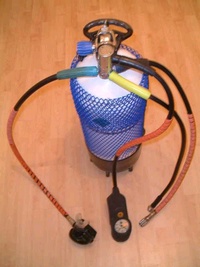
"Single-hose" open-circuit scuba
Most modern open-circuit scuba sets have a diving regulator consisting of a first-stage pressure-reducing valve fastened over the diving cylinder`s output valve. This valve cuts the pressure from the cylinder, which may be up to 300 bar, to a constant lower pressure, often about 10 bar above the ambient pressure, which is used in the "low pressure" part of the system. A relatively thin low-pressure hose links this with the second-stage regulator, or "demand valve," which is located in the mouthpiece. Exhalation occurs out of a one-way diaphragm in the chamber of the demand valve, directly into the water quite close to the diver`s mouth. This configuration type is called "single hose". The first make of this sort of scuba was the Porpoise, which was made in Melbourne, Australia by Ted Eldred. Some early single hose scuba sets used full-face masks instead of a mouthpiece, such as those made by Desco and Scott Aviation (who continue to make breathing units of this configuration for use by firefighters).
The first scuba set tradenamed Porpoise was a rebreather, but when a demonstration resulted in a diver passing out, Ted began to develop the single-hose open-circuit scuba system. Its regulator`s first stage and second stage had to be separated to avoid the Cousteau-Gagnan patent, which protected the double-hose scuba. In the process, Eldred also improved performance.
All modern scuba sets have a spare second-stage demand valve on its own second hose, a configuration called an "octopus" because it often has more hoses for other purposes coming out of the primary regulator on the cylinder top. This second "second-stage" regulator and hose, or "alternate air source", or "safe secondary" or "safe-second" for short, is typically yellow (signaling that it is an emergency or backup device). It is often worn secured into a clip on the stab-jacket or a special friction plug on a diver`s chest, easily available to be grabbed by, or offered to, a second diver short of air. In so doing, this second mouthpiece eliminates the need for two divers who need to share a cylinder to "buddy-breathe," by trading off the same mouthpiece. Diving instructors continue to teach buddy-breathing; then they show the new method that has superseded it. The original octopus idea was conceived by Sheck Exley as a way for single-file-swimming cave divers to share air in a narrow tunnel, but has now become the standard in recreational diving. Modern "octopus" type primary-stage regulators also typically feature high-pressure ports for use by dive-computer pressure-sensors, and additional ports for additional low-pressure hoses for inflation of dry suits and buoyancy compensator (BC) devices.
Increasingly, in the 21st century, "safety" secondary mouthpieces have been combined with the inflator and exhaust assembly of buoyancy compensator (BC) devices. This combination eliminates the need for a separate low pressure hose for the BC. Some diving schools now suggest that a diver offer another diver in trouble their primary mouthpiece (i.e. the one in their mouth), before going to their own safe-secondary. The idea here is that the diver not in trouble has much more time to sort things out with his/her own equipment after temporarily losing ability to breathe.